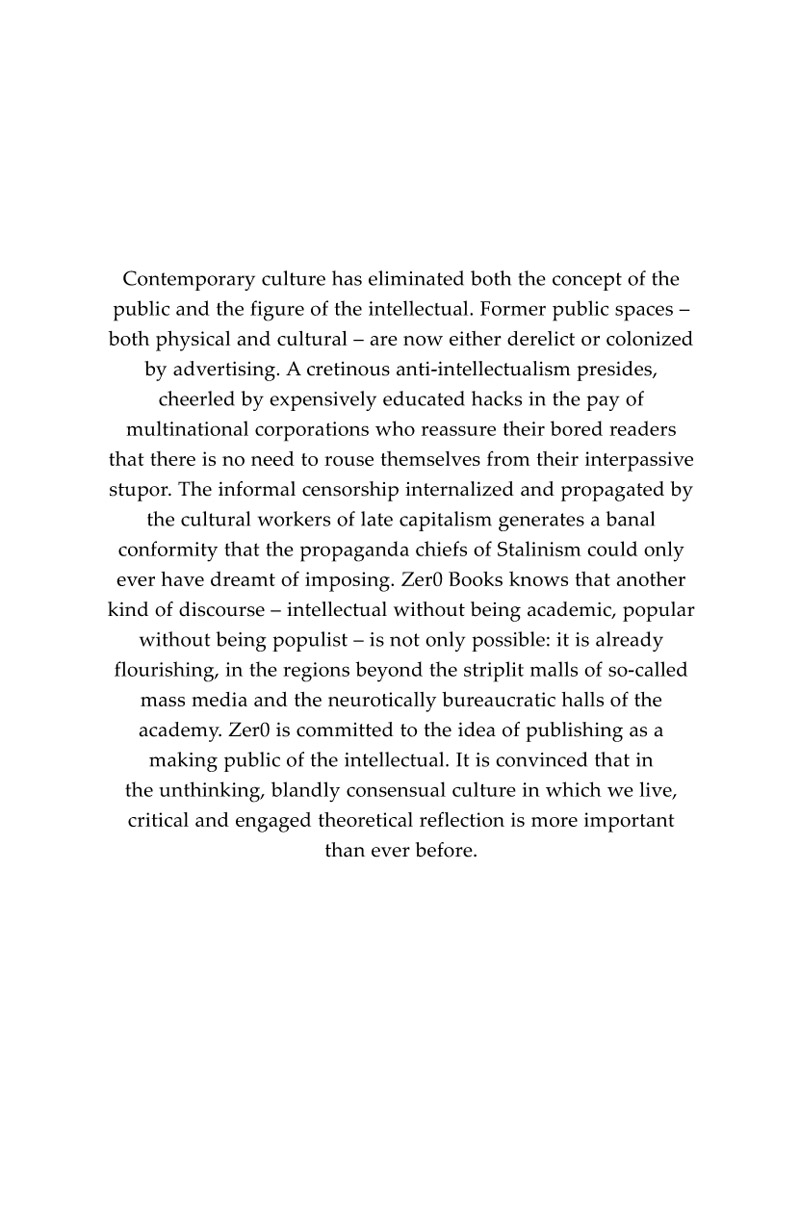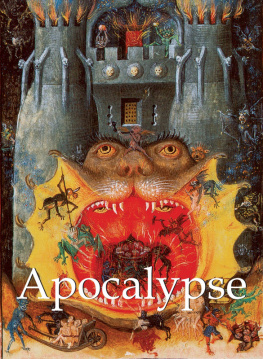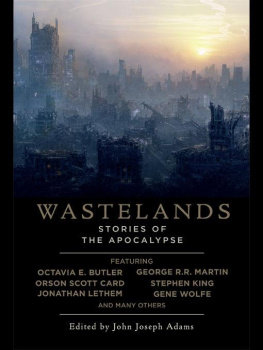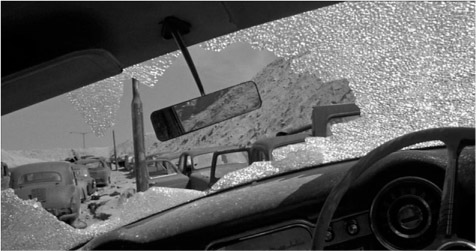Acknowledgements
Many thanks to many people. First and foremost, Erik Bachman and Ben Noys, whose comments on an earlier draft were invaluable. Marsh Leicester, along with Erik Bachman and Katie Woolsey, with whom I've watched a lot of movies over the past few years and whose thinking impels, challenges, and shapes my own. Ongoing dialogue with Alberto Toscano, fellow catastrophile, and China Miville, without whom salvagepunk is near unthinkable, has been crucial. My parents for decades of friendship and love. Olivia Egan-Rudolph for countless conversations and for making this past year infinitely better. Tariq Goddard and Mark Fisher for taking on and dealing with this behemoth, helping make something sharper of it. Laura Oldfield Ford for the cover image and for sharing the same love for things ruined and same hate for things that deserve to be.
Above all, thanks to my comrades in crisis out here in California. In these grey days, you're a hot torch, a joyous mob, and a promise to never go quiet into that bad night.

Salvagepunk
SHADES: No ones gonna repopulate the Big Apple now, not with the rat population what it is. Ya know, stuffs just going begging! Its salvage city, Max. Youd love it ... MOSES: Dont call me Max.
-from Richard Stanleys Hardware
They are residues of a dream world. The realization of dream elements, in the course of waking up, is the paradigm of dialectical thinking. Thus, dialectical thinking is the organ of historical awakening. Every epoch, in fact, not only dreams the one to follow but, in dreaming, precipitates its awakening. It bears its end within itself and unfolds it - as Hegel noticed - by cunning.
- Walter Benjamin, Expos of 1935, Das Passagen-Werk
THREE MOMENTS
One
World War I lays out a scattered corpse-scape, a shattered night of the world and its waste. Europe freezes, looking at its own death mask, cast from scrap wool and oil, black mud and dropped casings, all beneath the weight of a rotting international order and surging industry. Further east, the Bolsheviks say No and carve a trench into the plane of history. And in Berlin, Kurt Schwitters draws forth Merz from Commerz, pulling the innate venom of fragmented things from the bad sheen of commercial life.
Two
The 60s go kaputt. Then the long 70s roar into view, in all their gritty urgency and Satanic deformations of hippie non-thought, with real militancy losing a pitched battle to the triumphs of counter-revolution. In Italy, the Red Brigades shoot Moro and leave him in the trunk of a Renault. In New Hampshire, the end of the Bretton Woods system undoes the filaments of currency as certainty and shape. In England, 1969, The Bed Sitting Room and Monty Python think the end of it all as little more than the relentless repurposing of the same old shit. Ten years later, Mad Max heads toward the Outback.
Three
Neoliberalisms febrile tremors, and finance overcompensates, hysterically. There are small cracks and shimmers in this surface, like an old reptilian brain catching the whiff of older possibilities, false starts never quite taken. Cyberpunk already came and went: how could it not, given that it coldly sang along with what it felt like on the ground? Steampunk, the wet dream of Obama-time, acts twee and old fashioned while it sails smugly over the oceans of dead labor that got us here and sweeps the messy reality of progress out of sight. Salvagepunk isnt here yet, except as the unsteady movement of hands and brains trying to learn new tricks that have been there all along. Of the trash heap, only its romance of frozen decay should be discarded. There is no new construction, just the occupation of other architectures.
DREAM IMAGES
To return to and clarify the epigraph from Walter Benjamin: we are not talking about dream residues of a world, the nostalgic fantasies and fashionings of what once was. Rather, these are residues of a dream world that form a historical border to the next era, not as blueprints or utopian plans, but as leftovers. Rather, they are the unwelcome remainder of what wont go away. For what matters is neither manifest nor latent dream content. Its always the dream work, the underground currents that actually expose the loops of repression and the labor of making something out of these remnants.
The cunning of an era - the way it works against itself towards its own demise - is the dreaming of its grave. Not of its murderers or gravediggers, of whos to blame or who tried to put it to rest, but of the after-effect. The dream image, then, is the quiet cemetery3 For in rejecting the immediate past and the hard work of the living to bring around a new world order, one is left instead with the long dead and a pale writing of the now in their language. The ambiguous image, in contrast, (the un-worked-through dream image, not settled or stuck) is the rustling skeletons. Its the vision of a necromancers toolbox, with which we can refashion the dead into what we insist they could have been, and in doing so, clear a place for ourselves amongst the salvageable dead and the never quite gone.

In short ...
Steampunk. Well, something kind of like that, indeed, but ultimately not at all. Steampunk - an aesthetic that rewrites the outcome of late capitalism according to a different, kinder industrial trajectory - is the false dream image of these years. That falseness, however, doesnt lie in its being anterior (as the vision of a resolutely past era) or too dreamy, too fantastic. Its falseness lies in it being the wrong dream image, even while its the proper dream image of the liberal escape plan for the global crisis and its envisioned fall-out.
To track out this lineage of the present, we need to start with cyberpunk. If we are witnessing the slow self-dismantling of what can broadly be called a neoliberal order (the twin forces of financial deregulation and imperialism under the guise of globalization), we are also witnessing the eclipse of cyberpunk, at least as weve recognized it so far. Cyberpunk, that self-declared bastard child of science fiction, swapped out the cosmos and alternate worlds for a cooler, nastier version of this one: famous examples range from Gibsons Neuromancer (1984) and Stephensons Snow Crash (1992) to the total massification of cyberpunkish appearance in The Matrix trilogy. (Not to mention Cyberpunk, the 1993 Billy Idol album that nearly destroyed whatever remained of his career.) As a whole, it was a supposed non-movement, imitated all the same, full of artificial intelligence and information technologies run amok, neo-mercenaries and the revenge of the nerds (getting to wear virtual reality goggles and tight-fitting body suits, hackers playing postmodern day samurai), and glimpses of instantaneous data transmission stitched through the run-down corridors of the material city. Cyberpunk was the dream image of the neoliberal world par excellence, albeit one that encoded within it enough short-circuits to wake itself again and again. In particular, it wrote the fantasies of a post-state corporate global order. However, it did so with a canny awareness of the gap between the illusions of free-market ideology and the real need for states to act as support systems for corporate extension into recolonized spaces, material or virtual. Hovering over all this, in a froth alternately gray or giddy, were the visions of deindustrialization, of immaterial labor, of new hybrid multitudes, of nomadic subjects. And above all, of deregulation: credit, unchained and without master, races faster toward its own bartered-away abyss.



















